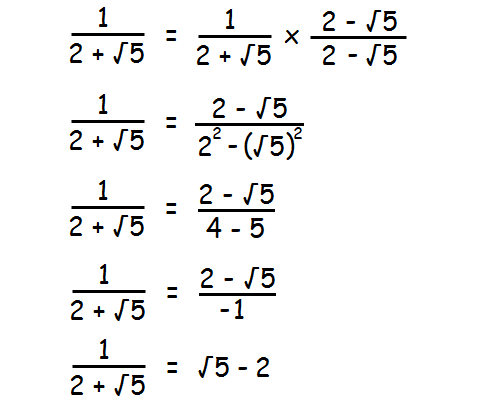SIMPLIFYING RADICAL EXPRESSIONS BY RATIONALIZING THE DENOMINATOR
Key Concept
Case 1 :
If the denominator is in the form of √b (where b is a rational number), then we have to multiply both the numerator and denominator by the same √b to rationalize the denominator.
Case 2 :
If the denominator is in the form of a ± √b or a ± c√b (where b is a rational number), then we have to multiply both the numerator and denominator by its conjugate.
a + √b and a - √b are conjugate to each other
a + c√b and a - c√b are conjugate to each other
Case 3 :
If the denominator is in the form of √a ± √b (where a and b are rational numbers), then we have to multiply both the numerator and denominator by its conjugate.
√a + √b and √a - √b are conjugate to each other
Examples
Example 1 :
Simplify :
18 / √6
Solution :
Simplifying the above radical expression is nothing but rationalizing the denominator.
So, rationalize the denominator.
Here, the denominator is √6.
In the given fraction, multiply both numerator and denominator by √6.
18 / √6 = (18√6) / (√6 ⋅ √6)
18 / √6 = 18√6 / 6
18 / √6 = 3√6
Example 2 :
Simplify :
1 / (2 + √5)
Solution :
Simplifying the above radical expression is nothing but rationalizing the denominator.
So, rationalize the denominator.
Here, the denominator is 2 + √5.
In the given fraction, multiply both numerator and denominator by the conjugate of 2 + √5. That is 2 - √5.

Example 3 :
Simplify :
(6 + √5) / (6 - √5)
Solution :
Simplifying the above radical expression is nothing but rationalizing the denominator.
So, rationalize the denominator.
Here, the denominator is 6 - √5.
In the given fraction, multiply both numerator and denominator by the conjugate of 6 - √5. That is 6 + √5.
(6 + √5) / (6 - √5) = [(6+√5)(6+√5)] / [(6-√5)(6+√5)]
(6 + √5) / (6 - √5) = [(6+√5)(6+√5)] / [(6-√5)(6+√5)]
(6 + √5) / (6 - √5) = (6 + √5)2 / [62 - (√5)2]
(6 + √5) / (6 - √5) = [62 + 2(6)(√5) + (√5)2] / (36 - 5)
(6 + √5) / (6 - √5) = [36 + 12√5 + 5] / 31
(6 + √5) / (6 - √5) = (41 + 12√5) / 31
Example 4 :
Find the values of 'x' and 'y' :
(2 + √3)/(2 - √3) = x + y√3
Solution :
(2 + √3)/(2 - √3) = x + y√3
On the left side of the above equation, multiply both numerator and denominator by the conjugate of 2 - √3. That is 2 + √3.
[(2+√3)(2+√5)] / [(2-√3)(2+√3)] = x + y√3
(2 + √3)2 / [22 - (√3)2] = x + y√3
[22 + 2(2)(√3) + (√3)2] / (4 - 3) = x + y√3
[4 + 4√3 + 3] / 1 = x + y√3
7 + 4√3 = x + y√3
Therefore,
x = 7
y = 4
Example 5 :
Simplify :
√(12x2) / √(30x)
Solution :
√(12x2) / √(30x) = √(12x2/30x)
√(12x2) / √(30x) = √(2x/5)
√(12x2) / √(30x) = √(2x) / √5
On the right side, multiply both numerator and denominator by √5.
√(12x2) / √(30x) = √(2x) ⋅ √5 / √5 ⋅ √5
√(12x2) / √(30x) = √(2x ⋅ 5) / 5
√(12x2) / √(30x) = √10x / 5

Apart from the stuff given above, if you need any other stuff in math, please use our google custom search here.
Kindly mail your feedback to v4formath@gmail.com
We always appreciate your feedback.
©All rights reserved. onlinemath4all.com
Recent Articles
-
Converting Between Polar and Rectangular Coordinates
Apr 23, 24 10:15 AM
Converting Between Polar and Rectangular Coordinates -
Converting Between Polar and Rectangular Equations Homework
Apr 21, 24 08:29 PM
Converting Between Polar and Rectangular Equations Homework -
Converting Between Polar and Rectangular Equations Worksheet
Apr 21, 24 01:23 AM
Converting Between Polar and Rectangular Equations Worksheet
